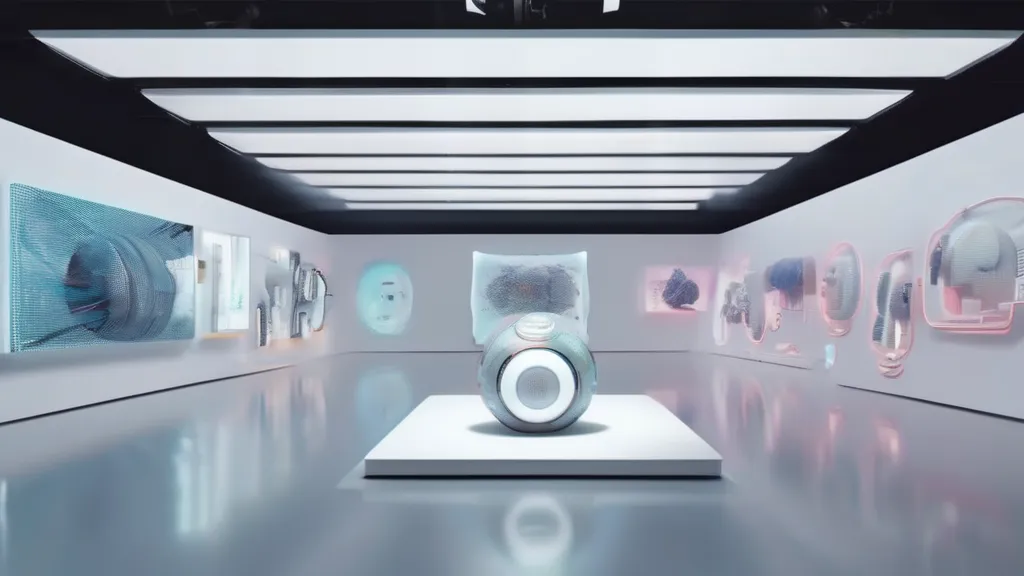The Digital Renaissance: How AI is Revolutionizing Creative Industries
Exploring the transformative impact of AI on art, music, film, and design.

- AI is revolutionizing creative industries by enhancing artistic expression and optimizing processes.
- Platforms like DeepArt and RunwayML enable new forms of art.
- AI tools such as Amper Music and AIVA empower musicians to create complex compositions.
- AI-driven animation and design tools are transforming workflows and democratizing content creation.
- Ethical considerations include potential biases and intellectual property rights.
Introduction: The Dawn of a New Creative Era
In the annals of technological advancement, few innovations have sparked as much intrigue and debate as Artificial Intelligence (AI). Today, AI is not just a tool for data analysis or automation; it is a formidable force reshaping the very fabric of creative industries. From art and music to film and design, AI is pushing the boundaries of what is possible, introducing novel forms of expression, and challenging the age-old paradigms of creativity.
AI in Art: Beyond the Canvas
The intersection of AI and art is perhaps one of the most captivating developments of our time. AI-driven platforms such as DeepArt and RunwayML have enabled artists to create pieces that were once inconceivable. Using neural networks, these platforms analyze and replicate artistic styles, allowing creators to blend traditional techniques with futuristic aesthetics.
In 2018, an AI-generated artwork titled “Edmond de Belamy” was sold for a staggering $432,500 at Christie’s Auction House, far exceeding its estimated value. This sale marked a pivotal moment, signaling the acceptance of AI as a legitimate tool in the art world. However, it also sparked a debate: What constitutes authorship in AI-generated art? Critics argue that while AI can mimic styles, it lacks the intentionality and emotional depth associated with human creation.
Music: Harmonizing Human and Machine
The music industry, too, is experiencing a revolution. AI tools like Amper Music and AIVA are empowering musicians to compose complex pieces with minimal input. These platforms utilize vast databases of musical compositions to generate new works that echo the intricacies of human creativity.
In 2020, the band Holly Herndon collaborated with an AI “baby” named Spawn to create an album that blurred the lines between human and machine-made music. This collaboration raised questions about the role of AI as a creative partner. Can AI truly understand the emotional nuances of music, or is it merely a sophisticated tool for composition?
Film and Animation: The New Frontier
AI is also making waves in the film and animation sectors. From scriptwriting to post-production, AI technologies are optimizing workflows and enhancing storytelling. For instance, the AI scriptwriting software ScriptBook can analyze scripts and predict box office success with remarkable accuracy. This technology is invaluable for producers looking to minimize financial risk.
Furthermore, AI-driven animation tools like Adobe’s Sensei are revolutionizing how animators work, reducing the time required for complex tasks and allowing creators to focus on the artistic aspects of their projects. However, this raises concerns about job displacement and the potential loss of traditional skills.
Design: Innovating the Visual Landscape
In the realm of design, AI is fostering innovation and efficiency. Tools such as Canva and Adobe Spark leverage machine learning algorithms to assist designers in creating visually appealing content effortlessly. These platforms democratize design, enabling individuals without formal training to produce professional-quality work.
However, the rise of AI in design also presents challenges. The reliance on AI-generated templates could lead to a homogenization of visual aesthetics, stifling originality and diversity in design.
The Ethical Quandary: Balancing Innovation and Authenticity
As AI continues to permeate creative industries, ethical considerations become increasingly pertinent. One of the primary concerns is the potential for AI to perpetuate biases present in the datasets it learns from. For example, AI-generated art could inadvertently replicate cultural biases, leading to a lack of diversity in artistic representation.
Moreover, the question of intellectual property rights looms large. Who owns the rights to an AI-generated piece of art or music? Legal frameworks are struggling to keep pace with technological advancements, leaving creators and consumers in a legal gray area.
Diverse Perspectives: A Global View
Globally, the integration of AI in creative industries is met with varied responses. In countries like Japan, AI is embraced as a complement to human creativity, enhancing traditional art forms with modern technology. Conversely, in regions with a strong emphasis on cultural heritage, there is resistance to AI’s encroachment, viewed as a threat to traditional crafts.
Conclusion: Embracing the Future
The advent of AI in creative industries heralds a new era of possibilities. While challenges exist, the potential for AI to augment human creativity is immense. To navigate this new landscape, a balanced approach is essential—one that embraces innovation while safeguarding the authenticity and diversity that define human creativity.
As we stand on the cusp of this digital renaissance, the question remains: How will we harness AI’s capabilities to enrich, rather than diminish, the creative spirit? The answers will shape the future of art, music, film, and design, forging a path toward a new creative horizon.
References
Call to Action
What are your thoughts on the role of AI in creative industries? Do you see it as a tool for empowerment or a threat to traditional artistic expression? Share your thoughts and join the conversation in the comments below.